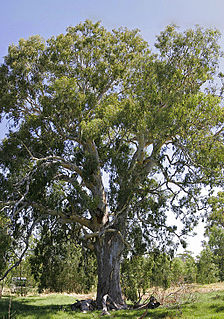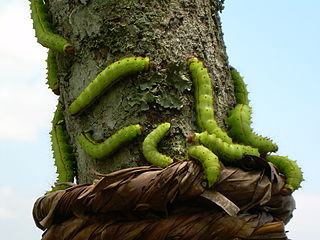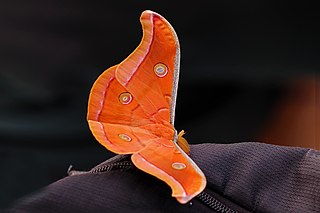
Colophospermum mopane, commonly called mopane, mopani, balsam tree, butterfly tree, or turpentine tree, is a tree in the legume family (Fabaceae), that grows in hot, dry, low-lying areas, 200 to 1,150 metres in elevation, in the far northern parts of southern Africa. The tree only occurs in Africa and is the only species in genus Colophospermum. Its distinctive butterfly-shaped (bifoliate) leaf and thin seed pod make it easy to identify. In terms of human use it is, together with camel thorn and leadwood, one of the three regionally important firewood trees.

The South Deccan Plateau dry deciduous forests is a tropical dry forest ecoregion in southern India. The ecoregion lies in the southernmost portion of the Deccan Plateau, and includes the southernmost portion of the Eastern Ghats.

Eucalyptus camaldulensis, commonly known as the river red gum, is a tree that is endemic to Australia. It has smooth white or cream-coloured bark, lance-shaped or curved adult leaves, flower buds in groups of seven or nine, white flowers and hemispherical fruit with the valves extending beyond the rim. A familiar and iconic tree, it is seen along many watercourses across inland Australia, providing shade in the extreme temperatures of central Australia.

Senegalia senegal is a small thorny deciduous tree from the genus Senegalia, which is known by several common names, including gum acacia, gum arabic tree, Sudan gum and Sudan gum arabic. In parts of India, it is known as Kher or Khor. It is native to semi-desert regions of Sub-Saharan Africa, as well as Oman, Pakistan, west coastal India. It grows to a height of 5–12 metres (16-40'), with a trunk up to 30 cm (1') in diameter. Sudan is the source of the world's highest quality gum arabic, known locally as hashab gum in contrast to the related, but inferior, gum arabic from Red acacia or talah gum.

Fraxinus latifolia, the Oregon ash, is a member of the ash genus Fraxinus, native to western North America.

Anogeissus is a genus of trees in the family Combretaceae. The 10 to 12 species are distributed in Asia and tropical Africa. Plants of the World Online now refers to this genus as a synonym of TerminaliaL.

Vachellia nilotica is a flowering plant tree in the family Fabaceae. It is native to Africa, the Middle East and the Indian subcontinent. It is also a Weed of National Significance in Australia as well as a Federal Noxious Weed in the United States.

Kuno National Park is a protected area in Madhya Pradesh that received the status of national park in 2018. The protected area was established in 1981 as a wildlife sanctuary with an area of 344.686 km2 (133.084 sq mi) in the Sheopur and Morena districts. It was also known as Kuno-Palpur and Palpur-Kuno Wildlife Sanctuary. It is in the Khathiar-Gir dry deciduous forests ecoregion.

Vachellia karroo, commonly known as the Sweet thorn, is a species of acacia, native to southern Africa from southern Angola east to Mozambique, and south to South Africa.

Madhuca longifolia is an Indian tropical tree found largely in the central and north Indian plains and forests. It is commonly known as madhūka, mahuwa, mahua, mahwa, mohulo, or Iluppai or vippa chettu. It is a fast-growing tree that grows to approximately 20 meters in height, possesses evergreen or semi-evergreen foliage, and belongs to the family Sapotaceae. It is adaptable to arid environments, being a prominent tree in tropical mixed deciduous forests in India in the states of Odisha, Chhattisgarh, Jharkhand, Uttar Pradesh, Bihar, Maharashtra, Telangana, Madhya Pradesh, Kerala, Gujarat, West Bengal and Tamil Nadu.

The Tadoba Andhari Tiger Reserve is a wildlife sanctuary in Chandrapur district of Maharashtra state in India. It is Maharashtra's oldest and largest national park. Created in 1955, the reserve includes the Tadoba National Park and the Andhari Wildlife Sanctuary. The reserve consists of 577.96 square kilometres (223.15 sq mi) of reserved forest and 32.51 square kilometres (12.55 sq mi) of protected forest.

Nagarjunsagar-Srisailam Tiger Reserve is the largest tiger reserve in India. The reserve spreads over five districts, Kurnool District, Prakasam District, Guntur District, Nalgonda District and Mahbubnagar district. The total area of the tiger reserve is 3,728 km2 (1,439 sq mi). The core area of this reserve is 1,200 km2 (460 sq mi). The reservoirs and temples of Srisailam are major attraction for many tourists and pilgrims. It is the largest tiger reserve forest in India.

Wild silks have been known and used in many countries from early times, although the scale of production is far smaller than that from cultivated silkworms. Silk cocoons and nests often resemble paper or cloth, and their use has arisen independently in many societies.

Dalbergia latifolia is a premier timber species, also known as the Indian rosewood. It is native to low-elevation tropical monsoon forests of south east India. Some common names in English include rosewood, Bombay blackwood, roseta rosewood, East Indian rosewood, reddish-brown rosewood, Indian palisandre, and Java palisandre. Its Indian common names are beete, and satisal. The tree grows to 40 metres in height and is evergreen, but locally deciduous in drier subpopulations.

Cordia sinensis is a species of flowering tree in the borage family, Boraginaceae. The species’ range extend from South Africa, through East Africa, Madagascar, West Africa and the Middle East to the Indian Subcontinent and Eastern Indochina. There is also a disjunct native population in Senegal. The species has become naturalised in Eastern Australia. Common names include grey-leaved saucer berry, grey-leaved cordia, marer, mnya mate, mkamasi and tadana.

Antheraea paphia, the South India small tussore, is a species of moth of the family Saturniidae found in India and Sri Lanka.
Alchornea latifolia is a species of tree in the family Euphorbiaceae. It is native to Central and South America, as well as the Caribbean, where its common names include aguacatillo, baconá and chote.

Antheraea mylitta is a species of moth in the family Saturniidae known commonly as the tasar silkworm and vanya silkworm. It is actually one of a number of tasar silkworms, species that produce Tussar silk, a kind of wild silk that is made from the products of saturniid silkworms instead of the domesticated silkworm. This species is native to India.
Daniellia oliveri is a species of tree in the family Fabaceae. It is native to tropical West and Central Africa and is commonly known as the African copaiba balsam tree, or the West African copal tree.



















